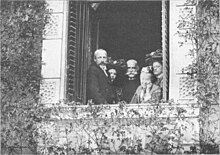Karl Stephan of Austria
Archduke Karl Stephan of Austria , full name Karl Stephan Eugen Viktor Felix Maria von Habsburg-Lothringen , from 1919 Karl Stephan Habsburg-Lothringen (born September 5, 1860 in Groß Seelowitz near Brno ; † April 7, 1933 in Żywiec ) was a member of the House of Habsburg-Lothringen and Admiral of the Austro-Hungarian Navy .
origin

Karl Stephan was the third son of Archduke Karl Ferdinand of Austria (1818–1874) and his wife Archduchess Elisabeth Franziska Maria of Austria (1831–1903), daughter of Archduke Joseph Anton Johann of Austria , Palatine of Hungary, and his third wife Duchess Maria Dorothea of Württemberg . His paternal grandparents were Archduke Karl von Österreich-Teschen and Princess Henriette Alexandrine von Nassau-Weilburg . Both his father and mother were grandsons of Emperor Leopold II , who is or was Karl Stephans's two-time great-grandfather.
siblings
- Franz-Joseph (* / † 1855)
-
Friedrich Maria Albrecht Wilhelm Karl (1856–1936), Duke of Teschen
⚭ 1878 Princess Isabella von Croÿ -
Maria Christina Désirée Henriette Felicitas Rainiera (1858–1929)
⚭ 1879 King Alfonso XII. from Spain - Eugen Ferdinand Pius Bernhard Felix Maria (1863–1954)
- Maria Eleonora (* / † 1864)
From his mother's first marriage, he had a half-sister, Marie Therese (1849-1919), who later became Queen of Bavaria.
Marriage and offspring
On February 28, 1886 Archduke Karl Stephan married Archduchess Maria Theresia (1862-1933), daughter of Archduke Karl Salvator of Austria-Tuscany and his wife Maria Immaculata of Naples-Sicily from the House of Bourbon-Sicily . The marriage had six children:
- Eleonora Maria (1886–1974) ⚭ Alfons von Kloss
- Renata Maria (1888–1935) ⚭ Prince Hieronymus Radziwill
-
Karl Albrecht (1888–1951), Prince of Altenburg
⚭ Alice Ankarcrona, widowed Countess Badeni - Mechthildis Maria Christina (1891–1966) ⚭ Prince Olgierd Czartoryski
- Leo Karl (1893–1939) ⚭ Countess Maria-Klothilde de Thuillières
- Wilhelm (1895–1948)
By marrying unequal Polish nobles, Renata and Mechthildis had to forego the succession for their sons. But Stephan promised them an anchor in Polishness and possible Polish candidate for the throne among his grandchildren. In 1913 Eleonora was allowed to marry the former captain of her father's yacht, with whom she fell in love at the age of 15.
Military career
Karl Stephan joined the Austro-Hungarian Navy in 1879 and retired from active service in 1896. He was still promoted: in 1911 he reached the rank of admiral. In 1918 he was transferred by Emperor Karl I to Cattaro / Kotor (in southernmost Dalmatia , today Montenegro ) in order to reorganize the navy together with Miklós Horthy after the mutiny that had occurred there. He was also the owner of the 8th Austro-Hungarian Infantry Regiment.
As a naval officer, Karl Stephan was interested in sailing and took part in several regattas in England.
Contender for the Polish crown
In June 1916, Karl Stephan was proposed by the German side as Polish regent. Emperor Franz Joseph , who wanted to become King of Poland himself, refused. On November 5, 1916, the German Emperor Wilhelm II and the Austrian heir to the throne Archduke Karl announced their plans for an independent Kingdom of Poland with a hereditary monarchy. Archduke Karl Stephan was again considered a contender for the Polish throne: he lived with his family in Żywiec (Saybusch) and spoke fluent Polish . Two of his daughters were married into Polish noble houses, Radziwiłł and Czartoryski . Since Karl Stephan was a member of the imperial house, he would have needed permission from the Austrian emperor to found his own dynasty. But Emperor Karl refused this permission because he was planning to have himself crowned King of Poland .
Awards
- Order of Malta
- Order of the Golden Fleece
- Elephant Order
- Royal Order of Seraphines
- Black Eagle Order
- Order of St. Stephen
Individual evidence
- ↑ See Nobility Repeal Act of April 3, 1919.
- ↑ from Sport & Salon . Vienna, April 4, 1908.
- ↑ Timothy Snyder : The King of Ukraine. The secret life of Wilhelm von Habsburg. Translated from the English by Brigitte Hilzensauer. Paul Zsolnay Verlag, Vienna 2009, ISBN 978-3-552-05478-3 , p. 77 ff.
- ↑ Timothy Snyder: The King of Ukraine. 2009, p. 81.
- ↑ Timothy Snyder: The King of Ukraine. 2009, p. 111f.
Web links
| personal data | |
|---|---|
| SURNAME | Karl Stephan of Austria |
| ALTERNATIVE NAMES | Karl Stephan of Habsburg-Lothringen; Karl Stephan Eugen Viktor Felix Maria von Habsburg-Lothringen (full name); Habsburg-Lothringen, Karl Stephan (name from 1919) |
| BRIEF DESCRIPTION | Member of the House of Habsburg-Lothringen and Admiral of the Austro-Hungarian Navy |
| DATE OF BIRTH | September 5, 1860 |
| PLACE OF BIRTH | Gross Seelowitz |
| DATE OF DEATH | April 7, 1933 |
| Place of death | Żywiec |

